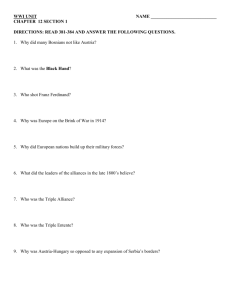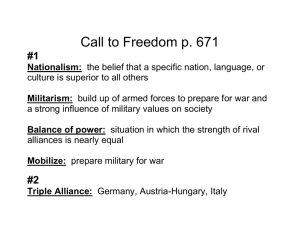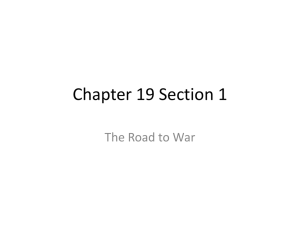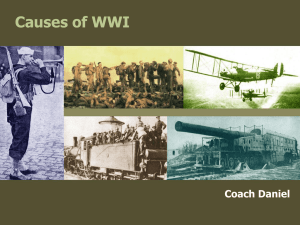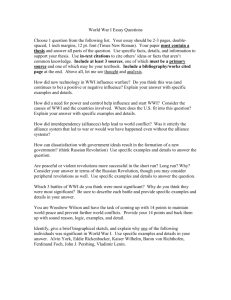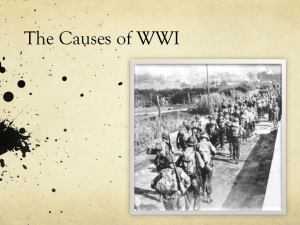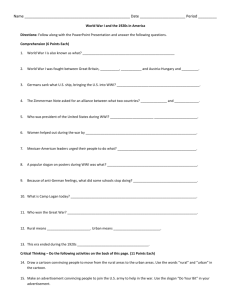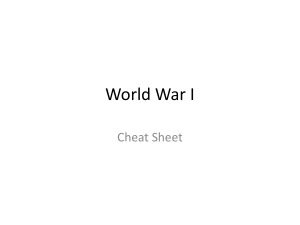US History II
advertisement
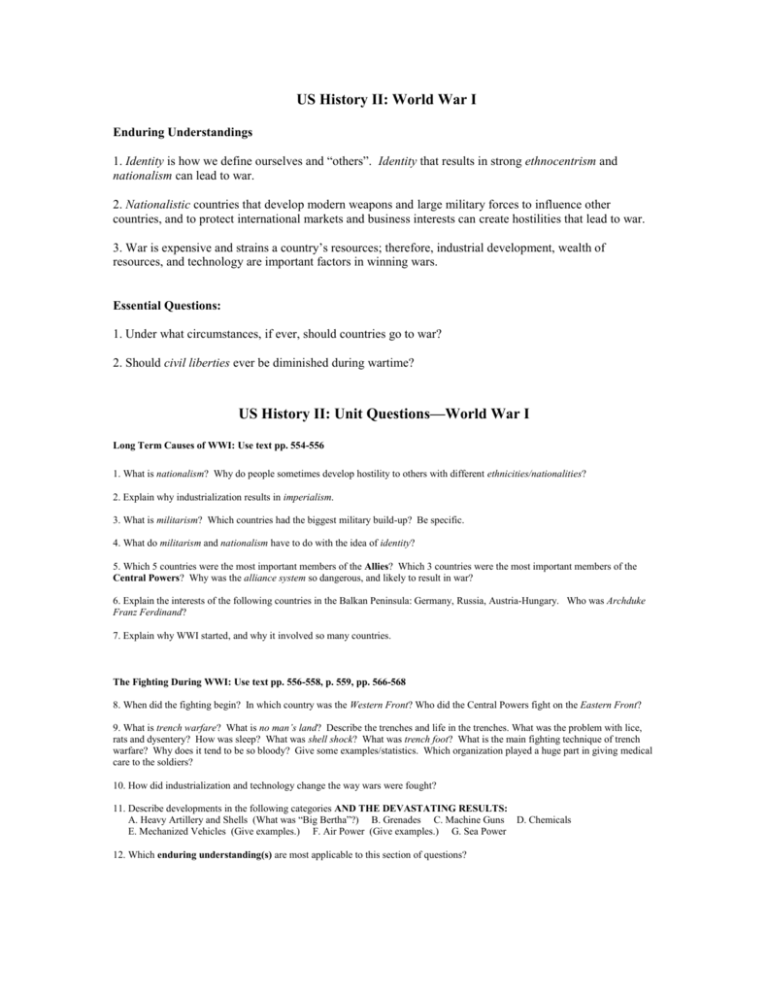
US History II: World War I Enduring Understandings 1. Identity is how we define ourselves and “others”. Identity that results in strong ethnocentrism and nationalism can lead to war. 2. Nationalistic countries that develop modern weapons and large military forces to influence other countries, and to protect international markets and business interests can create hostilities that lead to war. 3. War is expensive and strains a country’s resources; therefore, industrial development, wealth of resources, and technology are important factors in winning wars. Essential Questions: 1. Under what circumstances, if ever, should countries go to war? 2. Should civil liberties ever be diminished during wartime? US History II: Unit Questions—World War I Long Term Causes of WWI: Use text pp. 554-556 1. What is nationalism? Why do people sometimes develop hostility to others with different ethnicities/nationalities? 2. Explain why industrialization results in imperialism. 3. What is militarism? Which countries had the biggest military build-up? Be specific. 4. What do militarism and nationalism have to do with the idea of identity? 5. Which 5 countries were the most important members of the Allies? Which 3 countries were the most important members of the Central Powers? Why was the alliance system so dangerous, and likely to result in war? 6. Explain the interests of the following countries in the Balkan Peninsula: Germany, Russia, Austria-Hungary. Who was Archduke Franz Ferdinand? 7. Explain why WWI started, and why it involved so many countries. The Fighting During WWI: Use text pp. 556-558, p. 559, pp. 566-568 8. When did the fighting begin? In which country was the Western Front? Who did the Central Powers fight on the Eastern Front? 9. What is trench warfare? What is no man’s land? Describe the trenches and life in the trenches. What was the problem with lice, rats and dysentery? How was sleep? What was shell shock? What was trench foot? What is the main fighting technique of trench warfare? Why does it tend to be so bloody? Give some examples/statistics. Which organization played a huge part in giving medical care to the soldiers? 10. How did industrialization and technology change the way wars were fought? 11. Describe developments in the following categories AND THE DEVASTATING RESULTS: A. Heavy Artillery and Shells (What was “Big Bertha”?) B. Grenades C. Machine Guns D. Chemicals E. Mechanized Vehicles (Give examples.) F. Air Power (Give examples.) G. Sea Power 12. Which enduring understanding(s) are most applicable to this section of questions? America Enters the War: Use text pp. 558-561 13. In the early stages of the war, many Americans were opposed to getting involved. What criticism did American Socialists make about WWI? What did pacifists believe should be the international role of America? What did pacifist senator George Norris say against entering the war? 14. Explain how America had more economic ties to France and Britain than it had with Germany. Why did trade become even more intense between the Americans and the Allies after the war began? 15. Explain the results of the British naval blockade on the German food supply. What was the German Navy’s answer to the British naval blockade? 16. How did German u-boats draw America into World War I? What month and year did America enter the war? 17. Read Wilson’s “Personal Voice” on p. 561. How does the concept of identity appear in the reading? How about the importance of trade? Make a connection between trade and American Identity. 18. Which enduring understanding(s) are most applicable to this section of questions? Which essential question is most applicable? Explain why they are applicable. The American War Effort—People and Business: Use text pp. 562-566, pp. 569-574 19. Explain how the Selective Service Act worked. What was the nickname given to American soldiers during WWI? How did women contribute to the WWI military effort? Who was Alvin York? What is a conscientious objector? Explain the identity conflict that a conscientious objector like Alvin York goes through. 20. What was Secretary of War, Newton Baker’s quote about the nature of war? What does the quote mean? What was the job of the War Industries Board (WIB)? Describe 5 ways the WIB changed everyday life for Americans. 21. How was the war effort paid for? How did the government use the concepts of nationalism, hatred, and identity to help raise money for the war? Give examples. 22. Describe the “anti-immigrant hysteria”, and also, the problems associated with the Espionage and Sedition Acts. What do these things have to do with the concept of identity? What are civil liberties? Should the sacrifices of war ever include the reduction of civil liberties? Explain your answer. 23. Explain the idea of the “clear and present danger” ruling by the Supreme Court in Schenk v. United States (1919). 24. Explain which enduring understandings and essential questions apply to this question set. The War Ends: Use text p. 559, p. 565, pp. 567-568, pp. 578-579 25. When did WWI end? Explain why the Germans gave up fighting. What was the role of the British naval blockade in helping to end the war? 26. What is a Kaiser? Who was the Kaiser during WWI? What happened to him at the end of the war? 27. What was the final toll of WWI? What did this steep toll have to do with industrialization? 28. Who were the “Big Four” at the Treaty of Versailles? Were any of the leaders of the Central Powers present at treaty negotiations? When was the treaty signed? 29. Explain IN YOUR OWN WORDS, the major weakness of the Treaty of Versailles. What were reparations? What was the warguilt clause? Also IN YOUR OWN WORDS, explain how this would lead to the Second World War. (Be sure to mention economic conditions in Germany and Hitler.) Sample Short Essay: Why did Europe go to war in August of 1914? Europe went to war in August of 1914, but the long-term causes developed quite some time before. The four most important long-term causes were nationalism, imperialism, militarism, and the alliance system. The immediate cause of World War I was the Serbian assassination of Archduke Franz Ferdinand, the heir to the Austrian throne. Nationalism is excessive, narrow patriotism that can dull people’s sense of world citizenship, causing countries to be reckless in dealing with other human beings. This recklessness caused European countries like France and Germany to compete to be the dominant power in Europe, even at the expense of peace and global cooperation. Furthermore, various ethnic groups in Europe hoped to create countries of their own, especially if they lived under a powerful government that was controlled by a different ethnicity. Feelings of superiority can cause countries to believe that their customs, values, and government systems should be universal. So, for example, the Czechs were unhappy because Austria-Hungary would not even allow them to use their own language, and Serbs were discriminated against. Overall, nationalism created an environment of hostility in Europe that caused people to ignore the idea of their world citizenship. Imperialism was the idea that economically developed countries compete to control colonies in the undeveloped world. Industry often grows so big that it requires overseas markets, overseas resources, and overseas labor to allow it to continue growing. Colonies supplied imperial powers with raw materials like oil and rubber, and markets to sell their manufactured finished products. As Britain, France, and Germany industrialized, they sought more and more imperialist holdings. Industry will urge government to facilitate and protect international business, and such protection requires government to give military assistance. Imperialist competition added another ingredient to the growing feeling of hostility developing in Europe. Militarism was the development of powerful armed forces that were then used as a tool of diplomacy, and as a way to influence other countries. This can lead to war. These large militaries were designed to advance nationalist interests, and protect international business. Germany built the strongest army in the world. Great Britain had the strongest navy in order to protect its many shipping/trade routes. British, German, French, and American shipyards raced to build the largest battleships and destroyers. Businesses often profit from war, and government military policies designed to benefit business and industry can result in war. Alliances with other countries can result in war. Many countries in Europe sensed the growing hostility, and formed alliances promising to support one another in case of attack. By 1914, the Allies consisted of France, Great Britain, and Russia. The Central Powers consisted of Germany, Austria-Hungary, and the Ottoman Turks. In June 1914, in the Balkan Peninsula—“the Powder Keg of Europe”, a young Serbian nationalist shot and killed Archduke Franz Ferdinand of Austria. Austria-Hungary declared war on Serbia. This immediately drew Russia into the war because of their kinship with the ethnic Serbs. Russia’s entrance into the war pulled in all the other allies, and World War I, The Great War, The War to End All Wars, had begun by August 1914.

